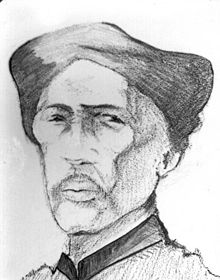Viet vu dao
Viet Vu Dao ( VietVuDao ) is an approximately 1,400 year old Vietnamese philosophy of life and martial art . The word means: the Vietnamese school of the five masters.
Viet Vu Dao is a martial art that includes both acrobatic, gymnastic and resting poles of realization. The ease of learning makes it possible for everyone who trains regularly to achieve a level of perfection that is high for his person after a short period of time. Viet Vu Dao can be practiced as a sport for controlled self-defense, since an attacker can be kept at a distance without great effort without seriously injuring him. During the training it is a matter of course for the trainers to set individual priorities for each individual in order to enable each follower to achieve a goal they have set themselves.
Viet Vu Dao is similar to traditional Kung Fu in certain aspects . It contains traditional, meditative and combative as well as social and cultural components of Vietnam.
History of the Vietnamese Martial Arts
origin
It is difficult to understand exactly when, how and by whom the martial arts came about. The omnipresent oral traditions testify to an absolute secrecy among the "great masters". This also explains why there is not even any ancient document about martial arts in China. However, there are bronze pieces that date back to the 3rd century before the Christian era and prove that there must have been a martial art in various, primary forms.
Chinese dominance
Because of the Chinese invasion of their country, the Vietnamese peoples migrated south. The Chinese, who were better organized and had more advanced weapons technology, dominated the Vietnamese for almost 1,000 years. But the gathering of the ethnic groups, the experience in combat and, above all, the desire for national independence led to the emergence of the techniques that would later represent the Vietnamese martial art. However, it is undeniable that this new martial art for the Vietnamese was strongly influenced by the Chinese knowledge of war.
From AD 900
The "Annales Impériales" ( 9th and 10th centuries ) indicate that the Chinese had increasing difficulties over the years to rule over the indigenous people of Vietnam. From AD 986 , the royal annals accurately describe the boom in Vietnam's military techniques. The Vietnamese martial arts have been handed down over the centuries by important families and mainly by showmen and other "traveling people". In families, the techniques were passed on from father to son, and the showmen used the martial arts to astonish the people and bring various miracle cures to the man.
From 1700
After all , Emperor Quang Trung was one of the first to speak of a Vietnamese martial art. He was a military genius who was imitated by many of the later great masters of Chinese martial arts. This man taught his army the most effective fighting techniques. From the original situation of a peasant uprising against the privileged class, he managed to defeat the Chinese armies of the Tsing in 1730 . This was thanks to some unknown techniques that took the opponent completely off guard.
From 1900
In the Doumer's epoch (1920), the leaders of Vietnamese society commissioned a young expert to ensure that the country's most important traditions were preserved. That expert was Pham Van Tàn. French rule had now lasted almost 40 years, and many feared the strong westernization of culture and customs to the detriment of Vietnam.
Origin of the Viet Vu Dao
founding
Pham Van Tàn was a direct student of the master Pham Van Thach (1850-1905), who was one of the experts in Vietnamese martial arts who were known from Saigon to beyond Camau. When Pham Van Thach died, he became the new administrator of the Vu Dao family from Dat Dao (a town south of Baria), and he purposefully followed the work of master Nguyen Van Hoa (1802–1880), his master's master, and founded the modern School of today's Viet Vu Dao.
export
Refugees eventually brought the basics of Viet Vu Dao to southern France (Marseille). From there, Viet Vu Dao soon spread. This sport first came to Germany in January 1992, where a steady group of committed sports enthusiasts slowly but steadily came together.
In Germany there are currently three clubs in which Viet Vu Dao is actively taught. Together with the German Federation, they are based in the community of Leinburg in the Nuremberg region, in Laufamholz in Nuremberg and in Mühlstetten .
See also
- Viêt Võ Dao (not the same as Viet Vu Dao despite the similar name)
- History of the Vietnamese Martial Arts
